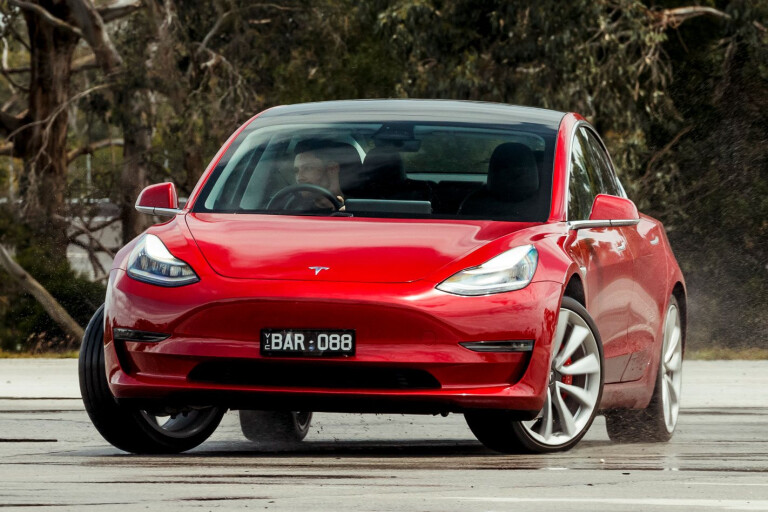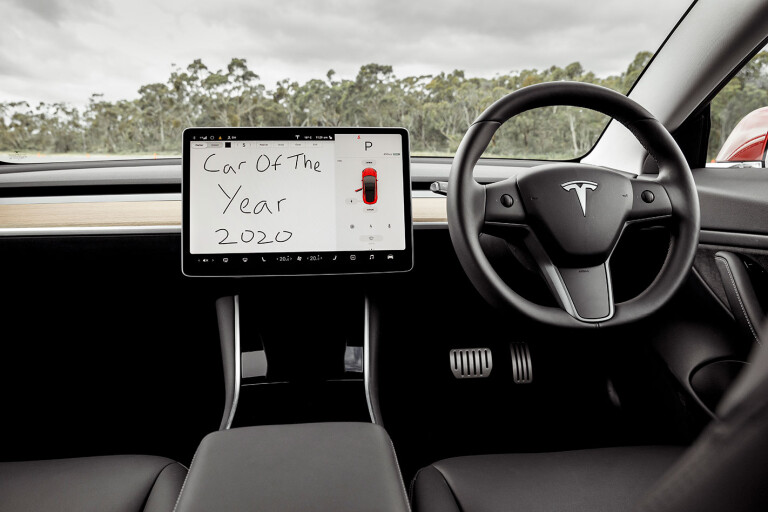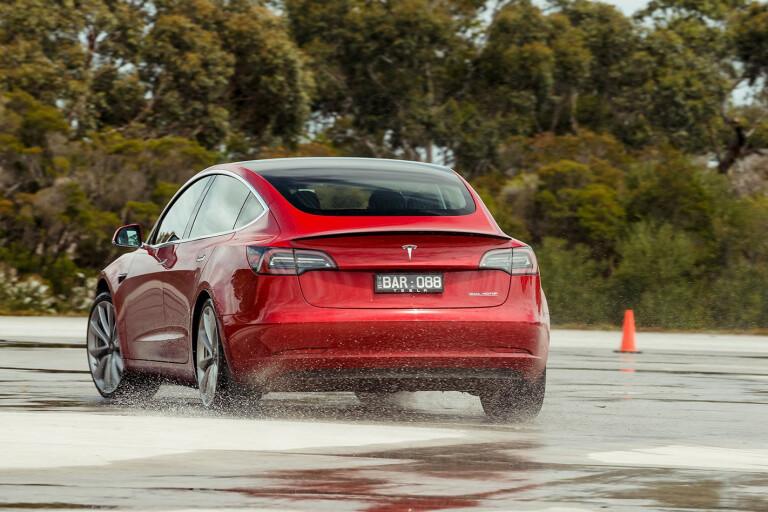
The red Tesla Model 3 Performance clawed momentarily at Lang Lang’s bitumen, then, like a slightly odd-looking aquarium fish fired from a slingshot, it flung itself to 100km/h in a scalding 3.5 seconds. That figure made it just 0.1sec slower than the fastest car in the COTY field, Porsche’s 911 Carrera S. But with the view from the Tesla a widescreen panorama across an ultra-low scuttle, the road appears closer and it actually feels faster than the German thoroughbred.
So considering that a sports sedan needs to provide suitably sporting performance, it was unanimous that the Model 3 got off to a screaming start against the Function criteria. Inwood, normally a bit of a hard man when it comes to supercar brutality, described the accelerative force as borderline uncomfortable.

He wasn’t alone. Several judges thought the Standard Plus version (powered by a single rear-mounted electric motor) was a more rounded, liveable proposition, and, with 0-100km/h in 5.3sec, one that still packs ample performance for daily duty.
But the Performance variant is no straight-line one-trick pony. The panel was unanimous in expressing praise (and a degree of surprise) as to how thoroughly sorted its outer-limit dynamics are, and the deft calibration of its traction and ESC systems. The ultra-quick steering and flat, composed handling all brought positive comments. “Amazing pace and dynamic grace,” noted Carey. Stopping power from the Performance was equally impressive: 37.2m from 100km/h in the dry, and a mere 0.5m further when the surface was wet.

Inside, the Model 3’s ultra-minimalist dash was less well received. While there was broad acknowledgment for the single-mindedness of the interior design, pretty much all judges felt having to glance down and sideways to see the speedo, and having to reach far left to the screen to poke at a small icon to change drive modes on the move, was a fail.
Then there was a clear use of budget materials in the cabin – everything from the upholstery to the steering wheel – as well as the lack of support from the spongey, cheap-feeling front seats. “It’s the Fantastic Furniture of car interiors,” quipped Noelle Faulkner.
This all chipped away at the otherwise strong-looking value case, as the price tag of the entry-level Standard Plus – $67,900 before on-road costs – was deemed keen given the technology and performance. More than one judge noted this mid-size sedan was $18,000 more expensive than the Nissan Leaf, but a whole galaxy ahead in terms of speed, space and sophistication.

So the Model 3’s passage out of Lang Lang and through to the final five was assured. Then it survived the second-round cull that claimed the 911 and RAV4, leaving it jostling among the top three. Suddenly the Yank EV disruptor was demanding consideration as to whether it was worthy of going all the way.
No question Efficiency was on its side. Both test cars consumed around 25kWh per 100km, which makes them more efficient than, say, the heavier Jaguar I-Pace and, as an aside, would translate in energy-consumption terms to using just 2.5L/100km. The inexpensive servicing (on long intervals) and low running costs also counted in the Model 3’s favour.
But ultimately it was a steady and growing collection of let-downs, rather than a major criteria fail, that kept the Model 3 from the COTY top step. The lack of knee airbags and no rear cross-traffic alert dented its safety cred. The low-rent cabin; the rattles and squeaks on rough roads; the apparent lack of sound deadening to quell road noise – all these were deemed not good enough for a car well north of $100K on the road in Performance spec, no matter how startling its point-to-point ability.

It was Carey who nailed Tesla’s apparent hubris that may need to be addressed before the company can make the next step in quality. “They tout this message: ‘We’re going to change the way cars are made; we’re going to do it better than any of the legacy car makers’,” said Carey. “But time is proving, actually, no they can’t. They have a lot to learn.”
THE JUDGE’S SCORECARD
Function: 3.3
Efficiency: 4.9
Safety: 3.4
Technology: 3.6
Value: 3.4
TESLA MODEL 3 SPECS
BODY
Type: 4-door sedan, 5 seats
Boot capacity: 542L
Weight: 1612 – 1847kg
DRIVETRAIN
Layout: Rear electric motor (east-west), RWD; front and rear electric motors (east-west), AWD
Motors: 3-phase AC permanent magnet synchronous (190kW/400Nm); dual 3-phase AC permanent magnet synchronous (335kW/640Nm total)
Transmission: Single-speed reduction gear
OTHER
Tyres: 245/45R18 – 245/35R20
Energy consumption: 24.2kWh/100km
CO2 emissions: 0g/km
Prices: $67,900 – $99,412

COMMENTS